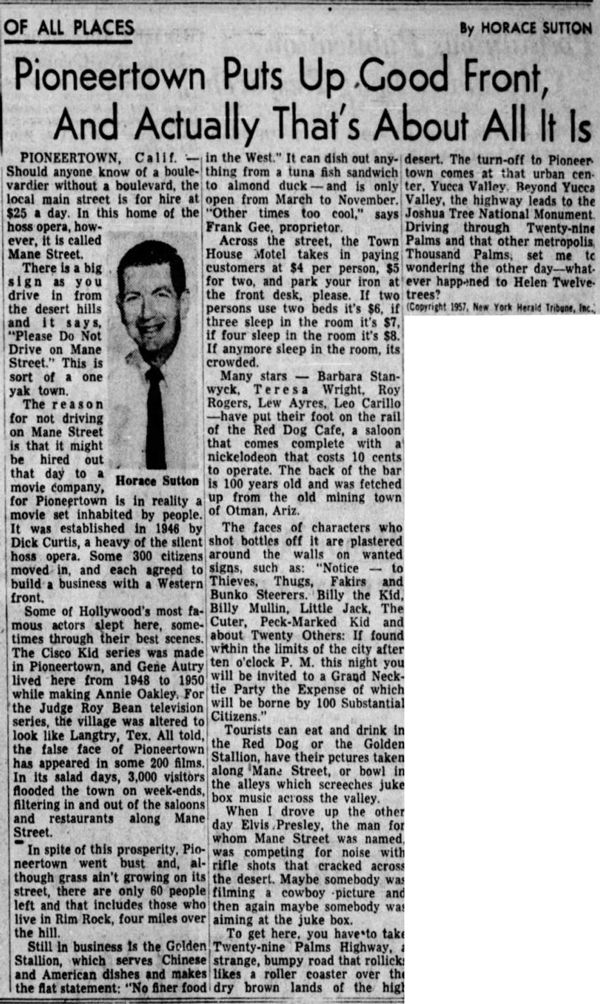Pioneertown Puts Up Good Front, And Actually That’s About All It Is
By Horace Button
PIONEERTOWN, Calif – Should anyone know of a boulevardier without a boulevard, the local main street is for hire at $25 a day. In this home of the hoss opera, however, it is called Mane Street.
There is a big sign as you drive in the fore desert hills and it says “Please Do Not Drive on Mane Street.” This is sort of a one yak town.
The reason for not driving on Mane Street is that it might be hired out that day to a movie company, for Pioneertown is in reality a movie set inhabited by people. It was established in 1946 by Dick Curtis, a heavy of the silent hoss opera. Some 300 citizens moved in, and each agreed to build a business with a Western front.
Some of Hollywood’s most famous actors slept here, sometimes through their best scenes. The Cisco Kid series was made in Pioneertown, and Gene Autry lived here from 1948 to 1950 while making Annie Oakly. For the Judge Roy Been television series, the village was altered to look like Langtry, Tex. All told the false face of Poineertown has appeared in some 200 films. In its salad days, 3,000 visitors flooded the town on weekends, filtering in and out of the saloons and restaurants along Mane Street.
In spite of this prosperity, Pioneertown went bust and although grass ain’t growing on it’s street, there are only 60 people left and that includes those who live in Rim Rock, four miles over the hill.
Still in business is the Golden Stallion, which serves Chinese and American dishes and makes a flat statement “No finer food in the West.” It can dish out anything from a tuna fish sandwich to almond duck – and is only open March to November. “Other times too cool,” says Frank Gee, proprietor.
Across the street, the Town House Motel takes in paying customers at $4 per person, $5 for two, and park your iron at the front desk, please. If two persons use two beds it’s $6, if three sleep in a room it’s $7, If four sleep in the room it’s $8 If anymore sleep in the room, it’s crowded.
Many stars – Barbara Stanwyck, Teresa Wright, Roy Rogers, Lew Ayres, Leo Carillo – have put their foot on the rail of the Red Dog Cafe, a saloon that comes complete with a nickelodeon that costs 10 cents to operate. The back car is 100 years old and was fetched up from the old mining town of Otman, Ariz.
The faces of characters who shot bottles off it are plastered around the walls on water signs, such as: “Notice – to Thieves, Thugs, Fakirs and Bunko Steerers. Billy the Kid, Billy Mullin, Little Jack The Cuter, Peck-Marked Kid and about Twenty Others: If found within the limits of the city after ten o’clock P.M. this night you will be invited to a Grand Necktie Party the Expense of which will be borne by 100 Substantial Citizens.”
Tourists can eat and drink in the Red Dog or the Golden Stallion, have their pictures taken along Mane Street, or bowl in the alley which screeches juke box music across the valley.
When I drove up the other day Elvis Presley, the man for whom Mane Street was named, was competing for noise with rifle shots that cracked across the desert. Maybe somebody was filming a cowboy picture and then again maybe somebody was aiming at the juke box.
To get here, you have to take Twenty-nine Palms Highway, a strange, bumpy road that rollicks like a roller coaster over the dry brown lands of the high desert. The turn-off to Pioneertown comes at that urban center, Yucca Valley. Beyond Yucca Valley, the highway leads to the Joshua Tree National Monument. Driving through Twenty-nine Palms and that other metropolis Thousand Palms, set me to wondering the other day – whatever happened to Helen Twelvetrees?

